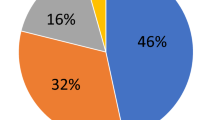Abstract
Feeding disorders in ex-prematures do exist and may constitute a major challenge to their families’ well being. A cases series of 86 ex-prematures with severe feeding disorders was analysed regarding co-morbidity, response to therapy and the long-term outcome after treatment. These children with a gestational age of <37 weeks had been referred for hospital rehabilitation because of severe feeding disorders, defined as tube feeding or average feeding times of more than 30 minutes. Behavioural therapy was the key element of the treatment. Ex-prematures accounted for 86/266 patients admitted for treatment of feeding disorders between 1995 and 2004. Whereas only 40.8% of these had cerebral palsy, 51.1% had a diagnosis of mental retardation and 87% had interaction problems. Response to treatment up to discharge was achieved in 61.6%. Univariat analyses showed that tube feeding at admission and swallowing difficulties were the best predictors of failure to respond to the intervention. Long-term follow-up data that were collected for 53 of the 86 children with similar initial response to therapy (64.2%) compared to children with no follow-up data (57.6%). Success of therapy after discharge was maintained in 94.1%; however, 25% of the children with normal BMI’s at discharge and sustained success of therapy fell below the 3rd BMI percentile. Cerebral palsy, mental retardation and interaction problems appear to be important risk factors for severe feeding disorders in ex-prematures. A therapeutic intervention based on behavioural therapy achieved sustained success in almost two thirds of the children.
Similar content being viewed by others
References
Bergman P, Graham J (2005) An approach to “failure to thrive”. Aust Fam Physician 34:725–729
Bundesamt (2004) Lebendgeborene und Gestorbene nach Geburtsgewicht und Ländern. Erhebung von 1973 und 2002
Castillo-Morales R, Brondo J, Hoyer H, Limbrock GJ (1985) Treatment of chewing, swallowing and speech defects in handicapped children with Castillo-Morales orofacial regulator therapy: advice for pediatricians and dentists. Zahnarztl Mitt 75:935–942, 947–951
Chatoor I (2002) Feeding disorders in infants and toddlers: diagnosis and treatment. Child Adolesc Psychiatr Clin N Am 11:163–183
Crosson DD, Pickler RH (2004) An integrated review of the literature on demand feedings for preterm infants. Adv Neonatal Care 4:216–225
Dunitz-Scheer M, Wilken M, Lamm B, Scheitenberger S, Stadler B, Schein A, Huber A, Schober P, Scheer P (2001) Sondenentwöhnung in der frühen Kindheit. Monatschr Kinderheilk 149:1348–1359
Field D, Garland M, Williams K (2003) Correlates of specific childhood feeding problems. J Pediatr Child Health 39:299–304
Hagberg B, Hagberg G (1996) The origins of cerebral palsy. Recent Adv Paediatr 67–83
Hannig C, Wuttge-Hannig A, Gerhardt P (1990) Contribution of roentgen cinematography to the diagnosis of pharyngo-esophageal diseases. Internist (Berl) 31:94–105
Hellbrügge T (1994) Münchener funktionelle entwicklungsdiagnostik
Hesse V, Bartezky R, Jaeger U, Kromeyer-Hauschild K, Zellner K, Vogel H, Bernhardt I, Hofmann A (1999) Körper-Masse-Index: Perzentilen deutscher Kinder im Alter von 0-18 Jahren. Kinderärztl Prax 8:542–553
Hintz SR, Poole WK, Wright LL, Fanaroff AA, Kendrick DE, Laptook AR et al (2005) Changes in mortality and morbidites among infants born at less than 25 weeks during the post-surfactant era. Arch Dis Child Fetal Neonatal Ed 90:128–133
Hofacker Nv, Papousek M (1998) Disorders of excessive crying, feeding, and sleeping: the Munich interdisciplinary research and intervention program. Infant Ment Health J 19:180–201
ICD-10 (1996) Multiaxiales Klassifikationsschema für psychische Störungen des Kindes- und Jugendalters nach ICD-10 der WHO (Bern: Huber)
Kaufman AS, Kaufman NL, Melchers P, Preuß U (2001) Kaufman assessment battery for children, deutsche version
Kedesdy JH, Budd KS (1998) Childhood feeding disorders: biobehavioral assessment and intervention. Paul. H. Brookes Publishing, C., Inc., Baltimore, Maryland
Limbrock GJ, Hesse A, Hoyer H (1987) Castillo-Morales orofacial regulation therapy method in children with brain lesions. Fortschr Kieferorthop 48:335–339
Lorenz JM, Wooliever DE, Jetton JR, Panet N (1998) A quantitative review of mortality and developmental disability in extremely premature newborns. Arch Pediatr Adolesc Med 152:425–435
Manikam R, Perman JA (2000) Pediatric feeding disorders. J Clin Gastroenterol 30:34–36
Marlow N, Wolke D, Bracewell MA, Samara M (2005) Neurologic and developmental disability at six years of age after extremely preterm birth. N Engl J Med 352:9–19
Papousek M (2005) Regulatory disorders in early childhood. Family physician counseling for crying, sleeping and feeding disorders. MMW Fortschr Med 147:32–34, 36, 38
Reilly S, Skuse D, Poblete X (1996) Prevalence of feeding problems and oral motor dysfunction in children with cerebral palsy: a community survey. J Pediatr 129:877–882
Rommel N, De Meyer A-M, Feenstra L, Veereman-Wouters G (2003) The complexity of feeding problems in 700 infants and young children presenting to a tertiary care institution. J Pediatr Gastroenterol Nutr 37:75–84
Sullivan PB, Lambert B, Rose M, Ford-Adams M, Johnson A, Griffiths P (2000) Prevalence and severity of feeding problems in children with neurological impairment: Oxford feeding study. Dev Med Child Neurol 42:674–680
Suss-Burghart H (2000) Fütter-und Gedeihstörungen bei kleinen und/oder behinderten Kindern. Z Kinder Jugendpsychiatr Psychother 28:285–296
Tellegen PJ, Winkel M, Lauros JA (1998) SON-R 2 1/2-7, Snijders-Oomen Non-verbaler Intelligenztest
Wolke D (2000) Fütterungsprobleme bei Säuglingen und Kleinkindern. Verhaltenstherapie 10:76–87
Acknowledgements
This work was supported by a grant from the association “Kinder im Zentrum e.V.”.
Many thanks also to Ladan Baghi for managing the data base.
Author information
Authors and Affiliations
Corresponding author
Rights and permissions
About this article
Cite this article
Schädler, G., Süss-Burghart, H., Toschke, A.M. et al. Feeding disorders in ex-prematures: causes - response to therapy - long term outcome. Eur J Pediatr 166, 803–808 (2007). https://doi.org/10.1007/s00431-006-0322-x
Received:
Accepted:
Published:
Issue Date:
DOI: https://doi.org/10.1007/s00431-006-0322-x




